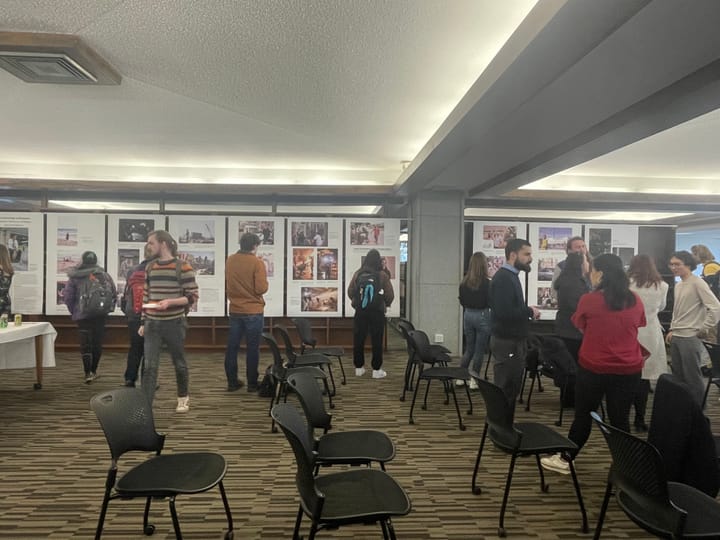The Common’s Latest Issue Features a Collection of Gripping Stories From Sudan
“The Common,” the biannual literary journal based at Amherst College, just released its 19th issue during the peak of COVID-19’s isolating effect, on April 27. It’s a time that presents both challenges and new opportunities for such a publication. When all heads are turned towards the small, repetitive loops of quarantined life, “The Common” offers an escape through literature, as it centers on stories of place.
This issue of “The Common” features short stories and art from artists in Sudan — enlivening and richly detailed tales of a nation that is most known, at least in the U.S., for war. The 11 fiction short stories all center around the lives of Sudanese people. While it is hard to summarize the diverse stories of the collection, the breadth of voices it offers invites exploration and discourse, both of which have been in short supply during the isolation of quarantine.
“The Common” has presented voices in contemporary Arabic fiction for many years, with portfolios similar to this edition’s highlighting Jordan in Spring 2018 and Syria in Spring 2019.
Sudan comes alive in the portfolio, which creates portholes into single moments of Sudanese life that hang open. They feel vivid and dynamic. The stories’ paths weave through families and homes, hinging on seemingly small moments in life that carry so much more than one might expect. In Ahmad Al Malik’s “Sara, Who Married A Dead Man,” the titular character bathes in the Nile, hoping to wash away her heavy past; she ends up bringing it back up even stronger. Many of the stories in the collection are similar in that they emphasize reflection and storytelling, active processes that consume and fill the page. The worn paths from our bedrooms to our kitchens feel empty in comparison.
But the stories do not only act as points of contrast to the world’s current predicament. If anything, the feelings of mourning and desire that so many of the stories contain feel more apt than ever. But, the characters in the collection face their feelings head-on with playfulness, a response that feels foreign from the monotonous barrage of dreadful news and statistics we face instead. The portfolio opens with Abdel-Ghani Karamalla’s “The Creator,” in which a young narrator ponders his true love’s marriage to another. He processes his loss through little mud animals that not only come alive, but also fill the symbolic empty spaces in his life. Amidst regret, the story holds up the mud figures without judgement; they are bound into the life of the narrator, and he is forced to confront the feelings that they represent. The story provides an opportunity to slow down and take in another life more freely. Like the narrator’s mud donkeys and doves, the shape of the world in isolation might be what we choose it to be.
The inevitable interruptions of war, capitalism and poverty intrude upon the playful lives in the stories. These pollutants take symbolic form in many of the stories. In Jamal Aldin Ali Alhaj’s “The Dam,” a singing father takes his daughter to the doctor after a scorpion bites her. The titular dam hangs over her worsening state and eventual death. A community is consumed by the dam’s construction in the same way that the daughter is consumed by the scorpion’s poison. The stories hold onto and sing to the moments surrounding tragedy: before the fall and after getting back up. “The Dam” parts with the reader by fading from the father still singing to his daughter: “Even the shadow is gone, and it left me with nothing to console me.”
Together, the stories make a collective history out of individual images of lives far away: a woman bathing and dreaming, a man making clay animals to mourn the loss of his love, a father singing to his daughter. Only, after reading about them, these lives don’t feel so far away.
The portfolio ends with a collection of art, courtesy of the Hindiyeh Museum of Art. My favorite is Rashid Diab’s “Last Dynasties.” The print is smoothed with burnt reds and smokey greys — a night on fire. But at its equator a puddle of blue sits like an ocean horizon, resting atop a bell of yellow-gold. Like other pieces in the portfolio, it takes the shape of life but refuses to restrict itself by means of this chameleon process. The loose form invites interpretation. The piece depends on perspective and could be anything else, too.
After reading all 11 stories, I feel as though I have learned, without the motivation of selfishness that often accompanies learning these days. The process of learning about Sudan’s world of contemporary fiction instead comes as a process of appreciation. Each author details and enumerates the various things with which they fill their lives and appreciate: foods, smells, sounds, impressions of others. The resulting details seem to collect and distill all the reasons the characters keep going and get on with their lives. The authors are not only storytellers: they become teachers of their personal perspectives.





Comments ()